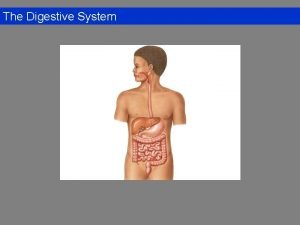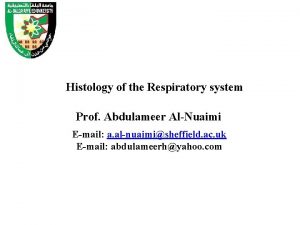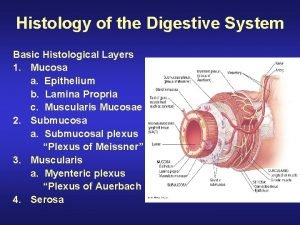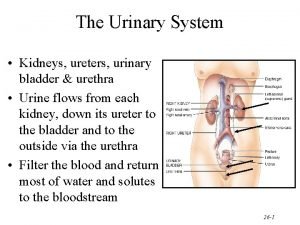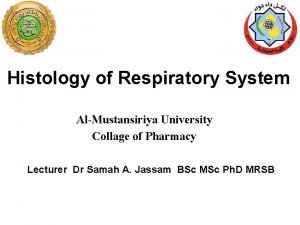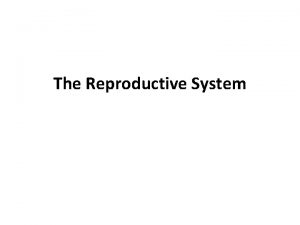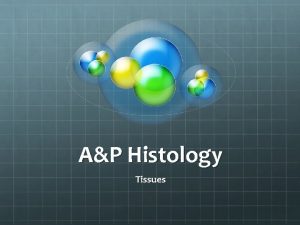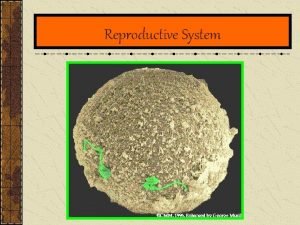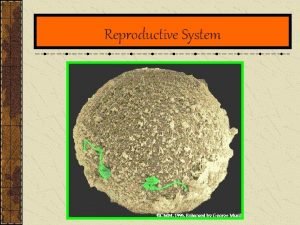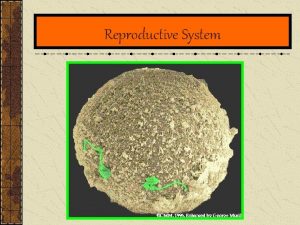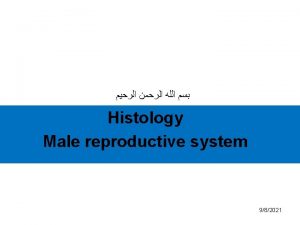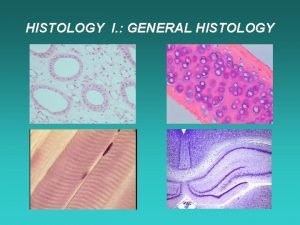Histology of Reproductive System AlMustansiriya University Collage of

















- Slides: 17

Histology of Reproductive System Al-Mustansiriya University Collage of Pharmacy Lecturer Dr Samah A. Jassam BSc MSc Ph. D MRSB

Role of the Reproductive System The Function of Female reproductive system 1 - To produce egg cells. 2 - To protect and nourish the offspring until birth. : The Function of male reproductive system 1 -It is to produce and deposit sperm.

The Testicles or Testes functions: 1 - Produce the male gametes or spermatozoa. 2 - Produce male sexual hormone (testosterone). Tunica albuginea a thick capsule surround the testes , from which a conical mass of connective tissue, the mediastinum testis, projects into the testis. Serosa connective tissue that covers the tunica albuginea externally.

The Convoluted Seminiferous Tubules These tubules are surrounded by 3 -4 layers of smooth muscle cells The insides of the tubules are lined with seminiferous epithelium, which consists of two general types of cells: 1 - Spermatogenium 2 - Sertoli cells

Spermatogonia 1 - Spermatogonium is an undifferentiated male germ cell. undergo spermatogenesis to form mature spermatozoa. There are three subtypes of spermatogonia in humans: Type A (dark) cells, with dark nuclei. which do not usually undergo active mitosis. Type A (pale) cells, with pale nuclei, they undergo active mitosis. These cells divide to produce Type B cells, which divide to give rise to primary spermatocytes.

The Sertoli cells 2 - Sertoli cells are the somatic cells of the testis that are essential for testis formation and spermatogenesis. Sertoli cells facilitate the progression of germ cells to spermatozoa via direct contact and by controlling the environment milieu within the seminiferous tubules.

Spermatogenesis It is the process in which spermatozoa are produced from spermatogonial stem cells by mitosis and meiosis. It occurs in the testis. https: //anatomytopics. wordpress. com/2009/0

Cells of Spermatogenesis process 1 - Spermatogonium: are the first cells of spermatogenesis. 2 - Primary spermatocytes: They appear larger than spermatogonia. They immediately enter the prophase of the first meiotic division, which is extremely prolonged. 3 - Secondary spermatocytes: smaller than primary spermatocytes. They rapidly enter and complete the second meiotic division.

Cells of Spermatogenesis process 4 - Spermatids: formed from the division of secondary spermatocytes, They are small with an initially very light (often eccentric) nucleus. 5 - Spermatozoa: The mature human spermatozoon is about 60 µm long and actively motile. It is divided into head, neck and tail. Spermiogenesis process : is the final stage of spermatogenesis, which sees the maturation of spermatids into mature, motile spermatozoa.

Female Reproductive System ovaries, oviducts, uterus and vagina Ovaries functions 1 -production and ovulation of oocytes 2 - the production and secretion of hormones The Structure of the Ovary ovary is divided into: - Outer cortex : consists of a very cellular connective tissue stroma where ovarian follicles are embedded. - Inner medulla: it is composed of loose connective tissue, which contains blood vessels and nerves.

Ovarian Follicles They are consist of one oocyte and surrounding follicular cells. Stages of Follicular development. 1 - Primordial follicle: are located in the cortex, one layer of flattened follicular cells surround the oocyte. 2 - Primary follicle: is the first morphological stage that marks the onset of follicular maturation, flattened cell surrounding the oocyte form a cuboidal or columnar epithelium surrounding the oocyte

3 - Secondary follicle: Small fluid-filled spaces become visible between granulosa cells as the follicle reaches a diameter of about 400 µm. 4 - The mature or tertiary or Graafian follicle: the follicle increases further in size. 5 - The stigma: The Graafian follicle forms a small "bump" on the surface of the ovary

Atresia refers to the degeneration of ovarian follicles that do not ovulate during the menstrual cycle. • about 400 oocytes ovulate and about 99. 9 % of the oocytes, that where present at the time of adulthood undergo atresia. • Atresia may effect oocytes at all stages of their "life" - both prenatally and postnatally.

The Oviduct The oviduct functions as a conduit for the oocyte, from the ovaries to the uterus. Histologically, the oviduct consists of a mucosa and a muscularis. The mucosa: is formed by a ciliated and secretory epithelium resting on a very cellular lamina. Some of the secreted substances are thought to nourish the oocyte and the very early embryo. The muscularis: consists of an inner circular muscle layer and an outer longitudinal layer. muscle action seems to be more important for the transport of sperm and oocyte than the action of the cilia.

The Uterus The uterus is divided into body and cervix. The walls of the uterus are composed of a mucosal layer, the endometrium, and a fibromuscular layer, the myometrium. The peritoneal surface of the uterus is covered by a serosa. 1 - Myometrium: The muscle fibres of the uterus form layers with preferred orientations of fibres. The muscular tissue hypertrophies during pregnancy 2 - Endometrium The endometrium consists of a simple columnar epithelium (ciliated cells and secretory cells) and an underlying thick connective tissue stroma.

3 - The endometrium can be divided into two zones based on their involvement in the changes during the menstrual cycle: the basalis and the functionalis. • The basalis is not sloughed off (appealed) during menstruation but functions as a regenerative zone for the functionalis after its rejection. • The functionalis is the luminal part of the endometrium. It is sloughed off during every menstruation and it is the site of cyclic changes in the endometrium.

Exercise Q 1: Name and define the stages of follicle development. Q 2: Numerate the subtypes of spermatogonia in humans: .
 Duct system female reproductive
Duct system female reproductive Endocrine system and reproductive system
Endocrine system and reproductive system Adventitia vs serosa
Adventitia vs serosa Histology respiratory system
Histology respiratory system Histology digestive system
Histology digestive system Nervous tissue histology ppt
Nervous tissue histology ppt Appendixis
Appendixis Digestive system histology
Digestive system histology The reticular layer
The reticular layer Urinary bladder
Urinary bladder Respiratory system histology
Respiratory system histology Uti causes
Uti causes Respiratory system logo
Respiratory system logo Male reproductive system from front
Male reproductive system from front Function of male reproductive system
Function of male reproductive system Male and female reproductive system
Male and female reproductive system Female reproductive system with baby
Female reproductive system with baby Ovarian ligament.
Ovarian ligament.


